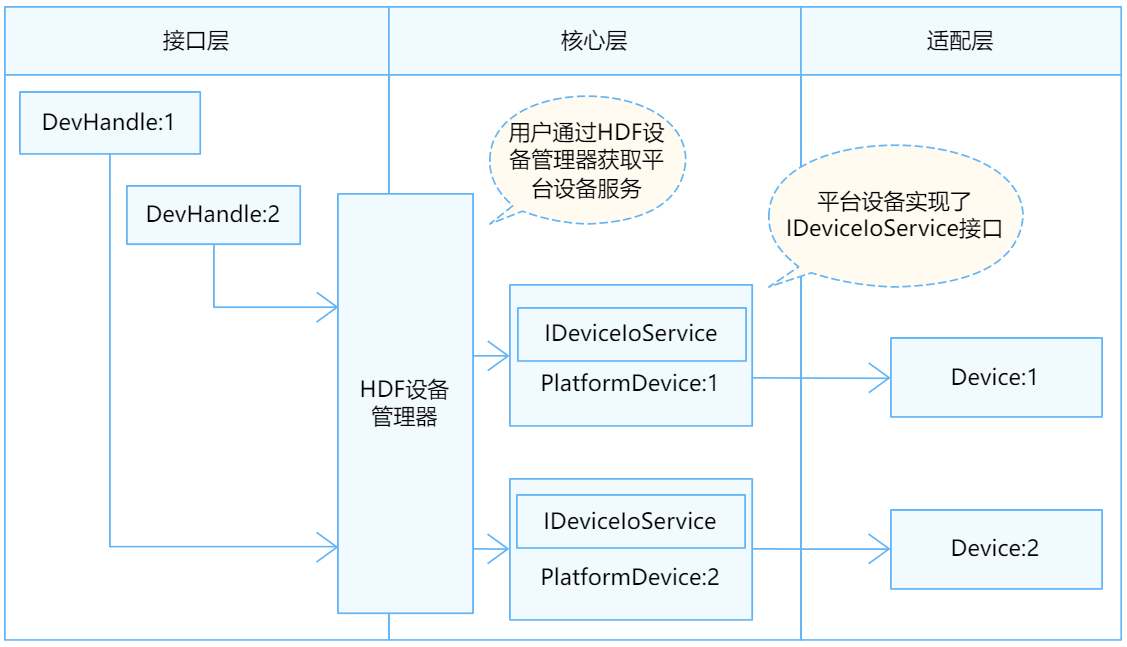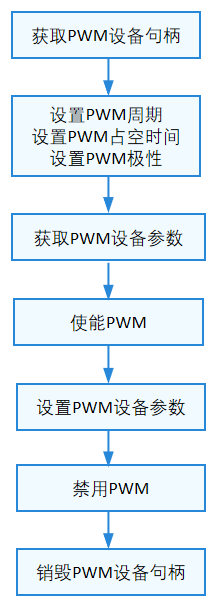PWM
概述
功能简介
PWM即脉冲宽度调制(Pulse Width Modulation)的缩写,是一种对模拟信号电平进行数字编码并将其转换为脉冲的技术。
PWM接口定义了操作PWM设备的通用方法集合,包括:
- PWM设备句柄获取和释放
- PWM周期、占空比、极性的设置
- PWM使能和关闭
- PWM配置信息的获取和设置
基本概念
脉冲是“电脉冲”的简称,指电路中电流或电压短暂起伏的现象,其特点是突变和不连续性。脉冲的种类很多,常见的脉冲波形有:三角脉冲、尖脉冲、矩形脉冲、方形脉冲、梯形脉冲及阶梯脉冲等。脉冲的主要参数包括重复周期T(T=1/F,F为煎复频率)、脉冲幅度U、脉冲前沿上升时间ts、后沿下降时间t、脉冲宽度tk等。
运作机制
在HDF框架中,PWM接口适配模式采用独立服务模式(如图1所示)。在这种模式下,每一个设备对象会独立发布一个设备服务来处理外部访问,设备管理器收到API的访问请求之后,通过提取该请求的参数,达到调用实际设备对象的相应内部方法的目的。独立服务模式可以直接借助HDF设备管理器的服务管理能力,但需要为每个设备单独配置设备节点,增加内存占用。
独立服务模式下,核心层不会统一发布一个服务供上层使用,因此这种模式下驱动要为每个控制器发布一个服务,具体表现为:
- 驱动适配者需要实现HdfDriverEntry的Bind钩子函数以绑定服务。
- device_info.hcs文件中deviceNode的policy字段为1或2,不能为0。
PWM模块各分层作用:
- 接口层提供打开PWM设备、设置PWM设备周期、设置PWM设备占空时间、设置PWM设备极性、设置PWM设备参数、获取PWM设备参数、使能PWM设备、禁止PWM设备、关闭PWM设备的接口。
- 核心层主要提供PWM控制器的添加、移除以及管理的能力,通过钩子函数与适配层交互。
- 适配层主要是将钩子函数的功能实例化,实现具体的功能。
图1 PWM独立服务模式结构图

使用指导
场景介绍
通常情况下,在使用马达控制、背光亮度调节时会用到PWM模块。
接口说明
PWM模块设备属性如表1所示,PWM模块提供的主要接口如表2所示。
表1 PwmConfig结构体介绍
| 名称 | 描述 |
|---|---|
| duty | 占空时间,以纳秒为单位。 |
| period | PWM周期,以纳秒为单位。 |
| number | 要生成的方波数: - 正值:表示将生成指定数量的方波 - 0:表示方波将不断产生 |
| polarity | 极性:正极性/反极性。 |
| status | 状态:启用状态/禁用状态。 |
表2 PWM驱动API接口功能介绍
| 接口名 | |
|---|---|
| DevHandle PwmOpen(uint32_t num) | 打开PWM设备 |
| void PwmClose(DevHandle handle) | 关闭PWM设备 |
| int32_t PwmSetPeriod(DevHandle handle, uint32_t period) | 设置PWM设备周期 |
| int32_t PwmSetDuty(DevHandle handle, uint32_t duty) | 设置PWM设备占空时间 |
| int32_t PwmSetPolarity(DevHandle handle, uint8_t polarity) | 设置PWM设备极性 |
| int32_t PwmEnable(DevHandle handle) | 使能PWM设备 |
| int32_t PwmDisable(DevHandle handle) | 禁用PWM设备 |
| int32_t PwmSetConfig(DevHandle handle, struct PwmConfig *config) | 设置PWM设备参数 |
| int32_t PwmGetConfig(DevHandle handle, struct PwmConfig *config) | 获取PWM设备参数 |
说明:
本文涉及PWM的所有接口,支持内核态及用户态使用。
开发步骤
使用PWM的一般流程如下图所示。
图2 PWM使用流程图

获取PWM设备句柄
在操作PWM设备时,首先要调用PwmOpen获取PWM设备句柄,该函数会返回指定设备号的PWM设备句柄。
DevHandle PwmOpen(uint32_t num);
表3 PwmOpen参数和返回值描述
| 参数 | 参数描述 |
|---|---|
| num | PWM设备号 |
| 返回值 | 返回值描述 |
| handle | 打开PWM设备成功,返回PWM设备句柄 |
| NULL | 打开PWM设备失败 |
假设系统中的PWM设备号为0,获取该PWM设备句柄的示例如下:
uint32_t num = 0; // PWM设备号
DevHandle handle = NULL;
handle = PwmOpen(num); // 打开PWM 0设备并获取PWM设备句柄
if (handle == NULL) {
HDF_LOGE("PwmOpen: open pwm_%u failed.\n", num);
return;
}
销毁PWM设备句柄
关闭PWM设备,系统释放对应的资源。
void PwmClose(DevHandle handle);
表4 PwmClose参数描述
| 参数 | 参数描述 |
|---|---|
| handle | PWM设备句柄 |
PwmClose(handle); // 关闭PWM设备销毁PWM设备句柄
使能PWM设备
int32_t PwmEnable(DevHandle handle);
表5 PwmEnable参数和返回值描述
| 参数 | 参数描述 |
|---|---|
| handle | PWM设备句柄 |
| 返回值 | 返回值描述 |
| HDF_SUCCESS | 使能成功 |
| 负数 | 使能失败 |
int32_t ret;
ret = PwmEnable(handle); // 启用PWM设备
if (ret != HDF_SUCCESS) {
HDF_LOGE("PwmEnable: enable pwm failed, ret:%d\n", ret);
return ret;
}
禁用PWM设备
int32_t PwmDisable(DevHandle handle);
表6 PwmDisable参数和返回值描述
| 参数 | 参数描述 |
|---|---|
| handle | PWM设备句柄 |
| 返回值 | 返回值描述 |
| HDF_SUCCESS | 禁用成功 |
| 负数 | 禁用失败 |
int32_t ret;
ret = PwmDisable(handle); // 禁用PWM设备
if (ret != HDF_SUCCESS) {
HDF_LOGE("PwmDisable: disable pwm failed, ret:%d\n", ret);
return ret;
}
设置PWM设备周期
int32_t PwmSetPeriod(DevHandle handle, uint32_t period);
表7 PwmSetPeriod参数和返回值描述
| 参数 | 参数描述 |
|---|---|
| handle | PWM设备句柄 |
| period | 要设置的周期,单位为纳秒 |
| 返回值 | 返回值描述 |
| HDF_SUCCESS | 设置成功 |
| 负数 | 设置失败 |
int32_t ret;
ret = PwmSetPeriod(handle, 50000000); // 设置周期为50000000纳秒
if (ret != HDF_SUCCESS) {
HDF_LOGE("PwmSetPeriod: pwm set period failed, ret:%d\n", ret);
return ret;
}
设置PWM设备占空时间
int32_t PwmSetDuty(DevHandle handle, uint32_t duty);
表8 PwmSetDuty参数和返回值描述
| 参数 | 参数描述 |
|---|---|
| handle | PWM设备句柄 |
| duty | 要设置的占空时间,单位为纳秒 |
| 返回值 | 返回值描述 |
| HDF_SUCCESS | 设置成功 |
| 负数 | 设置失败 |
int32_t ret;
ret = PwmSetDuty(handle, 25000000); // 设置占空时间为25000000纳秒
if (ret != HDF_SUCCESS) {
HDF_LOGE("PwmSetDuty: pwm set duty failed, ret:%d\n", ret);
return ret;
}
设置PWM设备极性
int32_t PwmSetPolarity(DevHandle handle, uint8_t polarity);
表9 PwmSetPolarity参数和返回值描述
| 参数 | 参数描述 |
|---|---|
| handle | PWM设备句柄 |
| polarity | 要设置的极性,正/反 |
| 返回值 | 返回值描述 |
| HDF_SUCCESS | 设置成功 |
| 负数 | 设置失败 |
int32_t ret;
ret = PwmSetPolarity(handle, PWM_INVERTED_POLARITY); // 设置极性为反
if (ret != HDF_SUCCESS) {
HDF_LOGE("PwmSetPolarity: pwm set polarity failed, ret:%d\n", ret);
return ret;
}
设置PWM设备参数
int32_t PwmSetConfig(DevHandle handle, struct PwmConfig *config);
表10 PwmSetConfig参数和返回值描述
| 参数 | 参数描述 |
|---|---|
| handle | PWM设备句柄 |
| *config | 参数指针 |
| 返回值 | 返回值描述 |
| HDF_SUCCESS | 设置成功 |
| 负数 | 设置失败 |
int32_t ret;
struct PwmConfig pcfg;
pcfg.duty = 25000000; // 占空时间为25000000纳秒
pcfg.period = 50000000; // 周期为50000000纳秒
pcfg.number = 0; // 不断产生方波
pcfg.polarity = PWM_INVERTED_POLARITY; // 极性为反
pcfg.status = PWM_ENABLE_STATUS; // 运行状态为启用
ret = PwmSetConfig(handle, &pcfg); // 设置PWM设备参数
if (ret != HDF_SUCCESS) {
HDF_LOGE("PwmSetConfig: pwm set config failed, ret:%d\n", ret);
return ret;
}
获取PWM设备参数
int32_t PwmGetConfig(DevHandle handle, struct PwmConfig *config);
表11 PwmGetConfig参数和返回值描述
| 参数 | 参数描述 |
|---|---|
| handle | PWM设备句柄 |
| *config | 参数指针 |
| 返回值 | 返回值描述 |
| HDF_SUCCESS | 获取成功 |
| 负数 | 获取失败 |
int32_t ret;
struct PwmConfig pcfg;
ret = PwmGetConfig(handle, &pcfg); // 获取PWM设备参数
if (ret != HDF_SUCCESS) {
HDF_LOGE("PwmGetConfig: pwm get config failed, ret:%d\n", ret);
return ret;
}
使用实例
下面将基于Hi3516DV300开发板展示使用PWM完整操作,步骤主要如下:
- 传入PWM设备号,打开PWM设备并获得PWM设备句柄。
- 通过PWM设备句柄及待设置的周期,设置PWM设备周期。
- 通过PWM设备句柄及待设置的占空时间,设置PWM设备占空时间。
- 通过PWM设备句柄及待设置的极性,设置PWM设备极性。
- 通过PWM设备句柄及待获取的设备参数,获取PWM设备参数。
- 通过PWM设备句柄,使能PWM设备。
- 通过PWM设备句柄及待设置的设备参数,设置PWM设备参数。
- 通过PWM设备句柄,禁用PWM设备。
- 通过PWM设备句柄,关闭PWM设备。
#include "pwm_if.h" // pwm标准接口头文件
#include "hdf_log.h" // 标准日志打印头文件
static int32_t PwmTestSample(void)
{
int32_t ret;
uint32_t num;
uint32_t period
DevHandle handle = NULL;
struct PwmConfig pcfg;
pcfg.duty = 20000000; // 占空时间为20000000纳秒
pcfg.period = 40000000; // 周期为40000000纳秒
pcfg.number = 100; // 生成100个方波
pcfg.polarity = PWM_NORMAL_POLARITY; // 极性为正
pcfg.status = PWM_ENABLE_STATUS; // 运行状态为启用
num = 1; // PWM设备编号,要填写实际平台上的编号
handle = PwmOpen(num); // 获取PWM设备句柄
if (handle == NULL) {
HDF_LOGE("PwmOpen: open pwm_%u failed!\n", num);
return;
}
ret = PwmSetPeriod(handle, 50000000); // 设置周期为50000000纳秒
if (ret != HDF_SUCCESS) {
HDF_LOGE("PwmSetPeriod: pwm set period failed, ret %d\n", ret);
goto ERR;
}
ret = PwmSetDuty(handle, 25000000); // 设置占空时间为25000000纳秒
if (ret != HDF_SUCCESS) {
HDF_LOGE("PwmSetDuty: pwm set duty failed, ret %d\n", ret);
goto ERR;
}
ret = PwmSetPolarity(handle, PWM_INVERTED_POLARITY); // 设置极性为反
if (ret != HDF_SUCCESS) {
HDF_LOGE("PwmSetPolarity: pwm set polarity failed, ret %d\n", ret);
goto ERR;
}
ret = PwmGetConfig(handle, &pcfg); // 获取PWM设备参数
if (ret != HDF_SUCCESS) {
HDF_LOGE("PwmGetConfig: get pwm config failed, ret %d\n", ret);
goto ERR;
}
ret = PwmEnable(handle); // 启用PWM设备
if (ret != HDF_SUCCESS) {
HDF_LOGE("PwmEnable: enable pwm failed, ret %d\n", ret);
goto ERR;
}
ret = PwmSetConfig(handle, &pcfg); // 设置PWM设备参数
if (ret != HDF_SUCCESS) {
HDF_LOGE("PwmSetConfig: set pwm config failed, ret %d\n", ret);
goto ERR;
}
ret = PwmDisable(handle); // 禁用PWM设备
if (ret != HDF_SUCCESS) {
HDF_LOGE("PwmDisable: disable pwm failed, ret %d\n", ret);
goto ERR;
}
ERR:
PwmClose(handle); // 销毁PWM设备句柄
return ret;
}